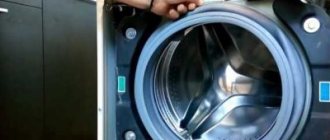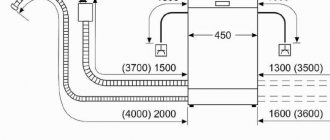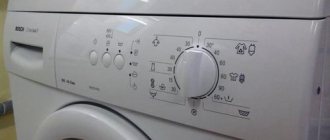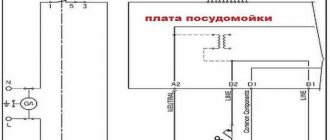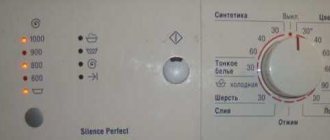A dishwasher can operate without failure for 8 to 10 years. But breakdowns also occur, including lack of water heating. This happens due to a malfunction of the heater. The PMM device is simple, so you can replace the heating element in the dishwasher yourself. We'll look at how to check and replace the element below.
How to make a replacement
The following is a step-by-step instruction explaining how to replace the heating element:
- In order to begin this work, you need to open the hopper door and empty the machine of the dishes.
- All operations are carried out with the machine turned off; it is necessary to disconnect it from the outlet and from the water supply in advance.
- If you look at the bottom of the dishwasher, you can see a plastic spray arm. It must be removed by pulling it towards you.
- A plastic glass can be seen next to it. A filter is placed in it. It also needs to be removed.
- Next, you need to remove the stainless steel mesh lying here.
- Next, you need to unscrew the five mounting screws and remove the heating block.
- In order to continue working further, you need to turn the dishwasher upside down.
- Now you need to open the back wall and take out the bottom panel.
- You can see that the heating element is connected to the pump. You need to grab it with your hands and turn it half a turn clockwise. Having done this, just pull this unit to the side and it can be easily removed. Now it's time to disconnect the sensor.
- You can see that the heater from below is held in place by a rubber piece. It needs to be removed. This is easy to do by sticking your hand under the plastic casing.
- Now all that remains is to disconnect the wires leading to the heater sensors, the pipes and remove the faulty heating element. A new, serviceable heating element is installed in this place.
After completing the replacement procedure, you need to assemble the car. To do this, the steps listed here must be performed in reverse order.
What else is important to remember when using dishwashers?
It is best to prevent any breakdown, and this directly depends on how correctly you operate your household appliances
It is very important to carry out regular cleaning of the device, which will preserve your kitchen appliances for a long time
Be sure to use your dishwasher regularly, since during periods of prolonged inactivity, bacteria can form inside the unit, which will negatively affect the health of your family. This appliance should only be cleaned when it is completely free of detergent and dishware residues. The first thing to check is the rotating sprayers, because there should be no blockages in them: very often these small holes become clogged with small debris from food and other things. Carefully check and remove debris from all elements of the machine; you can use thin tweezers or a toothpick for this. Be sure to wipe all doors and gaskets, you can do this with detergent, and an old toothbrush can help effectively clean hard-to-reach places
Treat the spaces between the gaskets well. Pay attention to the bottom of the door, since this area in many devices is dead and water does not enter here. A damp cloth can easily remove all debris and other contaminants. Pay special attention to the area at the bottom of the unit around the drain: to gain full access, remove the baskets and carefully remove all solids and other debris.
To protect yourself from injury, unplug the appliance before cleaning. Unfortunately, none of us are immune from absurd accidents that can result in breakdowns. If you need to replace the heating element for a Bosch dishwasher, then immediately think: can you handle the repair yourself, or is it better to use the help of a specialist.
Bosch, Ariston, Electrolux, and Candy dishwasher models contain two types of heating elements:
- Flowing or dry.
- Tubular with a spiral, or wet.
The first type is connected to the pump and pipe. Water is driven through its tube by a motor, so it heats up instantly. Such parts are less susceptible to scale and therefore have a long service life.
The second, submersible, element is combined with a circulation pump. Since it is constantly in water, it is more susceptible to scale deposits. Over time, the amount of salts on the surface interferes with normal heat transfer, causing the element to overheat and burn.
How do you know if the heater is broken and it’s time to replace it? Typical symptoms of a problem are described below.
Why does the heater break?
Heating the water in the washing machine is very important, since in hot water things are washed efficiently and efficiently. But, unfortunately, the service life of the heater is 3-5 years.
There are several reasons why an element fails:
- Natural wear and tear. The element constantly heats up and cools down, which shortens its service life.
- Scale. Untreated water contains impurities of salts that do not dissolve and settle on the surface of the heater. The thicker the layer of scale, the more difficult it is for the TEN to transfer heat. As a result, it overheats and burns out.
Voltage fluctuations in the network can lead to a short circuit. This, in turn, leads to a break in the heater circuit and a breakdown to the housing. Also, the reason that the element does not work may be the combustion of the triac on the electronic board. The triac is responsible for the operation of the heater, so if it malfunctions, the heating element does not receive a signal to act. Then you will need to replace or repair the heating element in your Bosch washing machine.
Symptoms of a problem
How can you determine the problem? Signs of a breakdown of the heating element in washing machines Bosch Classixx 5, Bosch Maxx 4, Bosch Maxx 5 and other models may be a lack of water heating.
To check, place your palm on the sunroof glass 20 minutes after the start of washing. If it is warm, it heats up, if it is cold, it does not.
Pay attention to your laundry after washing. In cold water, clothes are washed worse, they smell musty
It happens that the machine system itself signals a malfunction and shows error code F19 on the display. Then the user knows exactly what needs to be checked.
Causes of breakdowns and subtleties of choice
Problems with one of the main structural elements of the dishwasher can occur for various reasons. We invite you to take a closer look at possible problems, and also provide a number of tips for choosing a new TEN.
Why might TEN break?
According to user reviews, the most common failures of the electric heater in a dishwasher are burnt out spiral threads and electrical shorts at the tube terminals.
Burnout is a direct consequence of thinning of the refractory element located in the hermetically sealed heater.
Flow-through heating elements in dishwashers often burn out.
This may happen if:
- there is a leak in the heating element;
- there was a sharp surge in voltage in the power supply network (if such surges are a common occurrence, then it would not be a bad idea to purchase and install a stabilizer);
- the filter is very dirty;
- the machine is not being used correctly (it is advisable to read the operating instructions for the dishwasher before using it);
- wear, accumulation of a significant layer of scale on the heating element (if the layer thickness exceeds 2-3 mm, then failure of the element is inevitable).
With such serious breakdowns, there is nothing left to do but replace the burnt element with a new one. But before that you have to buy it, choosing the right one - any model will not work. In this matter, a number of features must be taken into account, which we will discuss below.
The nuances of choosing a new heating element
When ordering a spare part from online or service stores to replace it yourself, you must provide complete information about the model, including the serial number. The information is on the machine's label. We have provided detailed recommendations on finding and selecting quality spare parts for dishwashers here.
Also, when choosing a heating element, it is important to pay attention to its technical characteristics: carefully check its general purpose, power and voltage parameters, diameter similar to the factory ones, as well as compliance of the device with a standard connector for connection. We advise you to pay attention to maintaining tightness at the output ends of the purchased device
We advise you to pay attention to maintaining tightness at the output ends of the purchased device
Design features are also important
We advise you to pay attention to maintaining tightness at the output ends of the purchased device. Design features are also important. On the plastic body of the heating block there are outlets for connection to pipes and output ends for sensors
On the plastic body of the heating block there are outlets for connection to pipes and output ends for sensors
Design features are also important. On the plastic body of the heating block there are outlets for connection to pipes and output ends for sensors
Electric flow heaters heat quickly, but consume a lot of electricity. We recommend taking this into account: if you have a dishwasher and an electric kettle running at the same time, the plugs may fly out and the machine will turn off the power to the entire apartment.
Electric thermal heaters designed for installation in BOSCH dishwashers are available in the following designs:
- submersible (wet) – in contact with the working liquid medium, heating it;
- dry - surrounded for protection by a special flask made of durable composite material steatite.
Dry heaters are considered by professional craftsmen to be more effective in practice, because by eliminating direct contact with liquid they can last a very long time.
The wide flask of the dry heater helps to heat water very quickly, prevents the accumulation of scale, protects the machine from dry plugs, and can be easily dismantled
In various modifications of Bosch dishwashers, sensors for the distribution of water flows, water turbidity and an electric relay can be installed on heating elements, which is switched by a membrane moving under water pressure.
For Bosch dishwashers, heating elements are sold that are included with the pump. This is one single piece, so it is considered non-separable. Its cost is quite high and can vary in a wide price range: from 7,000 to 11,000 rubles.
Connection to water supply
The next stage of installation is connecting to the water supply. The dishwasher needs cold water. To do this, we shut off the supply from the riser or close the common house tap, cut in a tee and install a tap that cuts off the water supply to the dishwasher. If this is an end pipe, we simply install a single tap here. You can also use a three-piece with an already built-in faucet - these can be purchased at any plumbing store.
During the installation of the dishwasher, we seal all connections with fum tape, winding it in the direction of the thread. We tighten the nuts, check the tightness of the tap (the valve must be closed), and then connect the supply hose to the tee. There is no need to open the tap at the installation stage; all tests are carried out later, when everything is ready.
Is it possible to connect a dishwasher to a hot water pipe? During the installation process, many people, in an effort to save on electricity, want to connect to the hot water supply. There really is such a possibility, but before that you need to open the technical specifications of the purchased device and make sure that Bosch specialists allow the supply of hot water (as a rule, the maximum temperature is limited to +60 degrees).
Please note that if the passport contains a note that the maximum inlet temperature is +20 degrees, you cannot connect the Bosch dishwasher to a hot water supply - such an installation will void the warranty. Installing a dishwasher connected to a hot water riser is done in the same way as to a cold water riser. But you must remember that the quality of hot water supply in our country is far from ideal
If you make installations this way, be sure to ensure reliable filtration. Otherwise, you will be subject to loss of warranty, and possibly the purchase of spare parts for Bosch PM
But you must remember that the quality of hot water supply in our country is far from ideal. If you make installations this way, be sure to ensure reliable filtration. Otherwise, you will be subject to loss of warranty, and possibly the purchase of spare parts for Bosch PM
Installing a dishwasher connected to a hot water riser is done in the same way as to a cold water riser. But you must remember that the quality of hot water supply in our country is far from ideal. If you make installations this way, be sure to ensure reliable filtration. Otherwise, you will be subject to loss of warranty, and possibly the purchase of spare parts for Bosch PM.
Another disadvantage of this installation is that hot water from the tap does not start flowing immediately, but with some delay. Remember this when connecting to communications.
Internal organization
All spare parts and control elements are installed inside the bosch dishwasher body. The main details of this system are:
- A flow valve for water intake, which is equipped with an inlet system, controlled by a microcontroller.
- A filtration mechanism that cleans water from small parts of food and other debris.
- A drainage system consisting of a drainage pipe connected to a drainage system and a sump pump. It works on the same principles as the Bosch washing machine.
- Float-type blocker, protective system of the dishwasher from various leaks. It is a cylindrical plastic container that closes contacts when floating up. This happens when too much water is taken.
What else is important to remember when using dishwashers?
It is best to prevent any breakdown, and this directly depends on how correctly you operate your household appliances
It is very important to carry out regular cleaning of the device, which will preserve your kitchen appliances for a long time
Be sure to use your dishwasher regularly, since during periods of prolonged inactivity, bacteria can form inside the unit, which will negatively affect the health of your family. This appliance should only be cleaned when it is completely free of detergent and dishware residues. The first thing to check is the rotating sprayers, because there should be no blockages in them: very often these small holes become clogged with small debris from food and other things. Carefully check and remove debris from all elements of the machine; you can use thin tweezers or a toothpick for this. Be sure to wipe all doors and gaskets, you can do this with detergent, and an old toothbrush can help effectively clean hard-to-reach places
Treat the spaces between the gaskets well. Pay attention to the bottom of the door, since this area in many devices is dead and water does not enter here. A damp cloth can easily remove all debris and other contaminants. Pay special attention to the area at the bottom of the unit around the drain: to gain full access, remove the baskets and carefully remove all solids and other debris.
To protect yourself from injury, unplug the appliance before cleaning. Unfortunately, none of us are immune from absurd accidents that can result in breakdowns. If you need to replace the heating element for a Bosch dishwasher, then immediately think: can you handle the repair yourself, or is it better to use the help of a specialist.
Bosch, Ariston, Electrolux, and Candy dishwasher models contain two types of heating elements:
- Flowing or dry.
- Tubular with a spiral, or wet.
The first type is connected to the pump and pipe. Water is driven through its tube by a motor, so it heats up instantly. Such parts are less susceptible to scale and therefore have a long service life.
The second, submersible, element is combined with a circulation pump. Since it is constantly in water, it is more susceptible to scale deposits. Over time, the amount of salts on the surface interferes with normal heat transfer, causing the element to overheat and burn.
How do you know if the heater is broken and it’s time to replace it? Typical symptoms of a problem are described below.
What is needed for replacement
The thermoblock is one of the most difficult to repair and vulnerable to mechanical damage parts. Repairing a heating element for a dishwasher yourself is extremely difficult. To do this, you will need to seek the help of specialists, professional repairmen. It is often easier to replace the heating element with a new one. To do this, you only need a certain set of tools:
- Flathead and Phillips screwdrivers
- Multimeter for measurements and troubleshooting
- Pliers
- Awl
Ready! You can start disassembling. Experts advise starting repair work only if you are completely sure that the heating element is faulty. In this case, depending on the model, you will have to replace the heating element or the entire thermoblock. For example, for dishwashers from manufacturers Bosch, Electrolux or Indesit, the entire thermoblock will have to be replaced.
The thermoblock consists of sockets and connections for the sensor. The body of the spare part is made of plastic. If there are fasteners, you can unscrew these parts and remove the faulty heating element. If there are none, then you will have to replace the entire thermoblock. The price of the heating block depends on the model and series of the dishwasher. Usually it varies around 1000-4000 rubles.
We also advise you not to limit yourself to inspecting and repairing the thermoblock. When examining the “insides” of the dishwasher, you can find particles of mineral salts deposited on pipes and spare parts, or dirt that has clogged the filters. In the future, this will allow you to significantly save time and money if problems are detected, for example, problems with the discharge of used water.
Preparation for dismantling
Replacing a heating element in a Bosch SM is not the most difficult task. You can solve it yourself. What will you need? Tools, technical skills and patience, since disassembling an SMA is a slow and difficult task. Before changing the heating element in your Bosch washing machine, stock up on the following tools:
- screwdrivers - flat and figured;
- bit key;
- Torex type bat - size 10 mm;
- tester - measure resistance.
Buy a replacement part in advance. But take only the original heater. Tell the consultant the model of your washing machine, and he will select the appropriate option.
You can also find out exactly which heater you need after dismantling the part - there is a marking on it, which will help you look for the original spare part. The cost of original spare parts is quite high - about 1,500 rubles.
When might such a need arise?
Automatic diagnostics provide important assistance, but sometimes problems may arise when no error code is issued and the heating element needs to be checked. For example, everything works, but heating is much worse than in most cases. In this case, preventive measures are taken:
The machine is disconnected from the network, the water is drained and the dishes are unloaded. You must wait long enough for the machine to dry. Now you need to turn the dishwasher over and open it. How to do this depends on the model of the unit. In some cases you will have to remove the bottom panel, in others it is enough to remove the side wall. This is done in order to get to the sensor and carry out a check. You can check the heating element by visual inspection or use a multimeter for this. You must pay special attention to the serviceability of the wiring and contacts of the heater, measure the resistance of the heating element
It is important to check for melted areas or burning. If there is a malfunction, but nothing could be found, you need to either continue troubleshooting or contact a specialist.
It is important to think about the feasibility of repairing the heating element. If replacing the heating element together with the heating element is carried out on an outdated machine, the price of which is low, then you need to weigh what is more desirable for the owner: to carry out repairs or think about purchasing a new dishwasher
Can the machine be used without heating?
There should be no fundamental problems when using dishwashers without heating . However, you still won’t be able to get the expected result - the quality of washing will be extremely low. In addition, the electronics may completely fail to perform their work.
If the heating function fails and is detected by the machine's control system, the program may be interrupted and an error code will appear on the display. In this case, it will be impossible to obtain any result.
In any case, you should not try to wash dishes with a machine that is obviously faulty. One malfunction can lead to other, larger breakdowns, which will require serious repair costs.
Types of heating elements
The main problem with the heating element for a Bosch brand dishwasher is frequent overheating. This phenomenon is associated with growing layers of scale. This situation is inherent in a tubular electric heater, especially if specialized salt is not added to the softening water.
Flow type water heater (heater)
Bosch dishwasher heating elements can be:
- Submersible or so-called wet. Such a heating element has direct contact with the liquid and directly heats it.
- Dry, which are surrounded by a soapstone flask for protection.
Experts consider dry heaters to be more efficient. Due to the lack of direct contact with the working fluid, they can last much longer. A wide flask promotes rapid heating of water and the formation of less scale. Among other things, the dry heating element protects the dishwasher from dry plugs, and is quite easily dismantled for replacement with a new one.
Types of heating element in a dishwasher
Bosch, Ariston, Electrolux, and Candy dishwasher models contain two types of heating elements:
- Flowing or dry.
- Tubular with a spiral, or wet.
The first type is connected to the pump and pipe. Water is driven through its tube by a motor, so it heats up instantly. Such parts are less susceptible to scale and therefore have a long service life.
The second, submersible, element is combined with a circulation pump. Since it is constantly in water, it is more susceptible to scale deposits. Over time, the amount of salts on the surface interferes with normal heat transfer, causing the element to overheat and burn.
How do you know if the heater is broken and it’s time to replace it? Typical symptoms of a problem are described below.
Is repair possible?
The heating element in Bosch dishwashers is made using the technology of spraying a conductive layer onto an insulating substrate, but it is impossible to restore the track by soldering. The materials used at the plant do not allow the application of solder even with the use of acid flux. Repairs using a special paste that conducts electricity (used to restore heating filaments on car windows) are not recommended. The restored track will not withstand the increased current and temperature.
The company does not supply heater components for spare parts; if the motor or coil breaks down, the assembly must be replaced. There are non-original components on the spare parts market that are suitable in size and electrical parameters for Bosch dishwasher heaters. When using such parts, there is a risk of leakage from an incorrectly assembled heater or breakdown of the heating element due to poor quality components or incorrect connection.
It is possible to restore the heater using components taken from other faulty components. The technique is used in service centers that have a stock of parts. The disadvantage of such repairs is the likelihood of repeated failure due to the use of secondary components.
Replacing the heating element in a dishwasher
There is no more important part in a dishwasher than the heating element. It promotes water heating and thermoregulation. Therefore, if a breakdown occurs, you should urgently replace the heating element with a new one.
We’ll tell you why this happens and how to make the replacement yourself right now.
Therefore, if a breakdown occurs, you should urgently replace the heating element with a new one. We’ll tell you why this happens and how to make the replacement yourself right now.
Causes of malfunction and diagnostics
If you believe the reviews of owners of dishwashers of popular brands (Indesit, Bosch, LG, etc.), then the cause of heating element failure is most often a short circuit, as well as burnout of the spiral thread.
Also, the heating element can burn out due to a leak, major filter clogging, power surges, a scale layer of more than 3 mm and improper operation.
This is why we so often advise you to carefully study the rules for using equipment and regularly clean the filters yourself.
note
Thanks to timely care of your dishwasher, you can avoid many problems, including burnout of the heating element.
It is not difficult to diagnose a breakdown; in practice, the dishwasher simply stops heating the water; this will also be indicated by the temperature sensor readings.
It is possible to stop the program in the middle of the process or, on the contrary, “endless washing”. All this indicates a malfunction of the heating element.
How to choose a new heating element
First of all, open the documentation for your dishwasher (or the label on the case) and find out the exact model name. If you lose documents, you can find information on the Internet.
But it would be fair to talk about the differences between one heating element and another.
For example, electric instantaneous heaters quickly heat water to the required temperature, but at the same time they waste too much electricity.
These are used in Bosch dishwashers. Craftsmen consider second heaters (dry) to be of higher quality and more durable, since they do not come into contact with water.
Also, when choosing a heating element, it is important that it meets the power and voltage requirements, the connection of contacts and the diameter of your model
Where is the heating element located and how to change it yourself
So, you have correctly identified the faulty heating element, bought a new one and are now ready to replace it yourself. To do this, you will need a small set of tools that can be found in every home: flat and Phillips screwdrivers, ohmmeter, screwdriver, awl, pliers.
First you need to make sure that the new heating element really works. An ohmmeter will help with this; the resistance should not be higher than 25-30 ohms. If everything is in order, then:
- Unplug the dishwasher;
- Take out all the “internals”: dish trays, filter, sprinkler, hoses, etc.;
- The next step is to get rid of the spinning rocker arm. This is the lower part of the bunker, where heated water is pumped using a pump.
- Now you can see the pipe connected to the faulty heating element. Using a screwdriver, unscrew all the fixing screws (usually there are five of them) and turn the case over so that the bottom is on top;
- Get rid of the back panel. In some models, a retractable wall is installed instead; remove it completely;
- Next you will see a heating element that connects to the pump. It detaches with a slight half-turn to the right, after which the part must be pulled towards you in order to finally remove it. The sensor should also be disconnected;
- Remove the fasteners from the heating element. An awl will help to carefully pry them off;
- Now you can dismantle the faulty heating element by disconnecting the remaining pipes and plugs;
- Install the new heating element in reverse order.
Replacing the heating element of a dishwasher cannot be called such a complicated procedure, and all steps can be performed independently and at home. But if you are not confident in your abilities, we advise you to trust the repair or replacement of dishwasher spare parts to specialists.
When might such a need arise?
In order to make sure that it is necessary to replace this unit, there is no need to carry out detailed diagnostics of the dishwasher. Almost all modern dishwashers have a built-in fault detection system that can determine the location where the breakdown occurred. In this case, the corresponding error code should appear on the display. This is done on most modern dishwashers, for example, in Zanussi or Hansa.
Automatic diagnostics provide important assistance, but sometimes problems may arise when no error code is issued and the heating element needs to be checked. For example, everything works, but heating is much worse than in most cases. In this case, preventive measures are taken:
The machine is disconnected from the network, the water is drained and the dishes are unloaded. You must wait long enough for the machine to dry. Now you need to turn the dishwasher over and open it. How to do this depends on the model of the unit. In some cases you will have to remove the bottom panel, in others it is enough to remove the side wall. This is done in order to get to the sensor and carry out a check. You can check the heating element by visual inspection or use a multimeter for this. You must pay special attention to the serviceability of the wiring and contacts of the heater, measure the resistance of the heating element
It is important to check for melted areas or burning. If there is a malfunction, but nothing could be found, you need to either continue troubleshooting or contact a specialist.
It is important to think about the feasibility of repairing the heating element. If replacing the heating element together with the heating element is carried out on an outdated machine, the price of which is low, then you need to weigh what is more desirable for the owner: to carry out repairs or think about purchasing a new dishwasher
Why choose us?
- Free consultation by phone. In a telephone conversation, our manager will inform you about the possible cause of the breakdown and give you an estimated price for repairs. The technician will announce the exact cost of the work after diagnosing the faulty equipment.
- Free diagnostics and specialist visit. You will not have to pay for diagnostics of the dishwasher if you agree to its further repair by RemBytTech specialists.”
- Home repairs. There is no need to take faulty equipment to the workshop. RemBytTech specialists will repair it right at your home.
- Convenient work schedule. We work from 8 to 22 hours without weekends and holidays. Therefore, we will accept and fulfill your application even late on the weekend.
- Warranty up to 2 years. We confirm the quality of the work we have done by issuing a warranty card for a period of 3 months to 2 years, depending on the complexity of the repair.
Design and principle of operation
A heating element is an electrical device that heats liquid with a built-in spiral made of a special material. The conductive element is located in a sealed tube, which is isolated from the machine body. The heater is placed in a water jacket, and an electric vane pump is used to circulate the liquid. The joint line between the parts is sealed with a rubber gasket, which prevents water from entering the contact elements.
When an electric current passes through the coil, heat is released; measuring sensors are used to adjust the operation of the heater. The sensor controls the set temperature; when the required value is reached, the heater turns off. As soon as the water cools below the programmed threshold, the power supply is restored. Bosch tubular heaters installed in machines manufactured after 2010 are equipped with an additional pump that improves fluid circulation and accelerates heat transfer.
Bosch produces flow-through heaters with a tubular element in direct contact with the water flow.
On some modifications of dishwashers, there are dry-type units, distinguished by the installation of a heating tube in a separate housing. The gap between the walls is filled with a thermally stable compound, which further insulates the electrical components from water.
Internal organization
All spare parts and control elements are installed inside the bosch dishwasher body. The main details of this system are:
- A flow valve for water intake, which is equipped with an inlet system, controlled by a microcontroller.
- A filtration mechanism that cleans water from small parts of food and other debris.
- A drainage system consisting of a drainage pipe connected to a drainage system and a sump pump. It works on the same principles as the Bosch washing machine.
- Float-type blocker, protective system of the dishwasher from various leaks. It is a cylindrical plastic container that closes contacts when floating up. This happens when too much water is taken.
Step-by-step instructions for replacing the heating element
Have you decided to replace a faulty heating element in your dishwasher yourself?
Prepare the following set of necessary tools:
- 2 screwdrivers – flat and Phillips;
- screwdriver;
- multimeter or ohmmeter;
- pliers and awl.
The algorithm for independently replacing an electric heating element is as follows.
Main process
To make the entire technology for replacing heating elements in a dishwasher clear to you, we will provide it in the form of step-by-step instructions. Please note that different models of equipment may have slightly different fastenings, but in general the disassembly sequence is approximately the same.
So, all the work consists of the following 10 stages:
- Unplug the dishwasher and disconnect the water supply hose and drain.
- Open the door and remove the dish trays so that they do not interfere with replacement later.
- Remove the spray arm that is installed at the bottom of the dishwasher. To do this, pull the spray arm up.
- Unscrew the filter installed under the sprinkler and immediately remove the stainless steel mesh.
- Unscrew the screws that hold the pipe and the heating block itself.
- Turn the dishwasher upside down and provide access to the heating element. If the dishwasher is free-standing, you need to remove the back wall; if it is built-in, you need to remove the bottom panel.
- Remove the pump. This is quite simple to do - you just need to unscrew it clockwise and pull it to the side. Everything is done without much effort. Don't forget to disconnect the sensor, clamp and pipe.
- Reach under the body and remove the rubber fasteners holding the heating element, as well as the hose.
- Carefully remove the inoperative heater.
- Replace the heating element with a new one and reassemble the dishwasher in the reverse order.
Tread pattern
Different categories of roads have their own tread patterns.
They come in several types. Slick. Smooth pattern, suitable for road and racing bikes.
What types of heating elements are there and what are their advantages?
Modern heating elements can be not only tubular, but also flow-through. The first are, as mentioned above, a spiral, which is placed at the bottom of a special washing chamber. Flow devices are a heated water-conducting tube that is located outside the chamber. It is the flow-through heating elements that cope with their task much faster than tubular ones, but at the same time they consume a huge amount of energy.
Tubular heating elements for Bosch dishwashers are more economical, but they require careful care. As a rule, such devices oblige housewives to use only carefully selected dishwashing detergents, as well as additional solutions or powders, to prevent the formation of scale. Tubular elements heat water by converting electrical energy into thermal energy.
Starting a test cycle
Bosch dishwashers have a test mode that can be run as a troubleshooting measure. The method to run this test process is similar across the Bosch range, so if your machine's functions seem to differ from those described below, it's worth experimenting as the process is similar with only minor differences.
To start the test mode, hold down the POWER SCRUB PLUS and REGULAR WASH buttons. Holding down the ON/OFF button may also help. The indicator above them should blink.
You can now check the status of each program by clicking a button, or you can run a full testing period.
Press the Power SCRUB PLUS and REGULAR WASH buttons. The electronic device will start and when the selected mode has ended, if you do not have a display, the indicator on your dishwasher model will light up if a fault has been detected.
Part replacement
The heating element system is located quite close to other control units. It is this circumstance that makes replacing the heating element in an appliance such as a dishwasher quite a troublesome task. To successfully replace your dishwasher heating element, follow these instructions:
- Open the hopper panel and remove the dish tray.
- Disconnect the unit from the electrical network and disconnect all connections.
- Remove the plastic irrigation mechanism located at the bottom of the dishwasher.
- There should be a plastic cylinder next to it. This is a filter, remove it.
- Remove the steel net located below.
- Remove the five screws securing the hose and heater flow blog.
- Install the unit on the top panel, providing free access to the bottom.
- Remove the back panel.
- Remove the pump. To do this, unscrew it clockwise and then gently pull it to the side. Remember: it is enough to turn it half a turn, do not make sudden movements. Remove the temperature sensor and set the pump aside.
- The heating element is attached to the bottom of the machine with a rubber element. It comes off quite easily.
- Remove the rubber fasteners, disconnect the hoses and wiring. Remove the failed heating element from the system and replace it with a new one.
The heating element is called the heart of the dishwasher, and this statement is not far from the truth. Critical damage can cause irreparable damage to the entire device, as well as lead to leaks and big troubles. Monitor its performance, descale it regularly and replace it if necessary. The heating element installation process will not take much time, and timely intervention will save you from even bigger problems.


